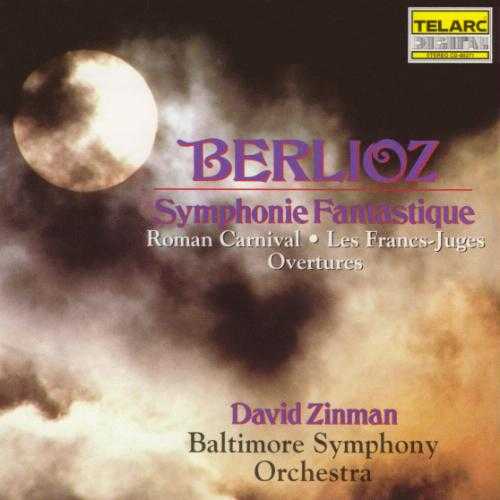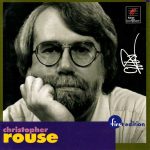
Orchestra: Baltimore Symphony Orchestra
Conductor: David Zinman
Composer: Hector Berlioz
Audio CD
SPARS Code: DDD
Number of Discs: 1
Format: FLAC (tracks+cue)
Label: Telarc
Size: 261 MB
Recovery: +3%
Scan: yes
* Le carnival romain (Roman Carnival Overture), ouverture catactéristique for orchestra, H.95 (Op. 9)
Composed by Hector Berlioz
Performed by Baltimore Symphony Orchestra
Conducted by David Zinman
01. Berlioz: Roman Carnival Overture, Op. 9
02. Berlioz: Les Francs-Juges Overture, Op. 3
03. Berlioz: Symphonie fantastique: I. Reveries, Passions (Dreams, Passions)
04. Berlioz: Symphonie fantastique: II. Un Bal (A Ball)
05. Berlioz: Symphonie fantastique: III. Scene aux champs (Scene in the Country)
06. Berlioz: Symphonie fantastique: IV. Marche au supplice (March to the Scaffold)
07. Berlioz: Symphonie fantastique: V. Songe d’une nuit de sabbat (Dream of the Witches’ Sabbath)
Comparative Review — Zinman a Winner
In writing about these two recordings (the Zinman on Telarc v. the Boulez on DGG) , I believe I am going to end up sounding like (of all people!) Harry Pearson. I am here referring to the Harry Pearson who could write about two power amplifiers (think of HP comparing an expensive solid state unit with an expensive tube unit) by first praising the solid-state for its good qualities (excellent bass, great detailing ability, etc.), but then when he got around to writing about the tube unit, he would then pull out all the rhetorical stops.
After conceding that his favorite had some flaws (maybe the bass was a little tubby, maybe there were some little hints of coloration here and there), he would then manage to make those flaws sound not like problems, but rather like endearing qualities that just make the tube amp all the more desirable. He would then go on to make it clear that despite its flaws, the amp he favored was preferable by miles and miles to the more technically proficient, less flawed, but less loveable unit.
I used to get a real chuckle out of reading that kind of stuff in the pages of The Absolute Sound. I hope that at least a few readers will get a chuckle out of what I am going to say about these two recordings.
I am actually quite an avid fan of Pierre Boulez, and when I got picked up his CD, I was quite excited. I played it a few times, marveled at the orchestral playing, enjoyed the good sound, but then started looking for other recordings to play.
When I put on the Zinman, I just flat-out enjoyed the music more. What’s more, I enjoyed the sound more. In fact, having reacquainted myself with the Zinman disk, I quickly decided that I never wanted to listen to the Boulez again. The difference was just that stark.
However, I had a review to write, so I forced myself to compare these two recordings many times. The more I did, the stronger my preference grew.
OK, I’ll confess. I’m seriously in love with the dark, burnished sound of the Telarc Baltimore recordings. They are fabulous! Moreover, the dark, burnished sound seemed to add a sense of mystery and excitement that were perfectly appropriate for Berlioz’s mysterious, exciting score.
Yes, the DG sound is truly excellent, too: very detailed and clean, with plenty of dynamic range, but the effect is just too clinical for this music. Those who want to study every little detail of the score might prefer the DG sound, but those who want to revel in the music need to listen to the Telarc on a full-range system.
In some of my comparisons of recordings, I try to give a movement-by-movement synopsis and comparison of the two recordings, picking little nits here and there, but in this case I am not going to do so, because I favor the Zinman version so strongly. (Let me point out quickly that although Boulez is the true Frenchman here, Zinman is a protégé of the late French conductor, Pierre Monteux.)
I will bring up just one quick musical example this time: Zinman marches his hero to the scaffold in a brisk 4:37, which seems exciting. Boulez, however, stretches this stroll out to more than seven minutes.
Having expressed a clear preference for the Zinman recording on Telarc, must I express one word of caution. The more I listened to these two recordings, the more bored I got with the music. After a while, in fact, I did not even want to listen to the Zinman any more. There are just so many other orchestral pieces I would rather listen to!
This is the first time I have run experienced this kind of “musical burnout” in doing one of these comparisons–in fact, it is usually a great pleasure to delve more and more deeply into a pair of recordings. But not this time.
Yes, Berlioz’s orchestration is really colorful, but when you really come down to it, some of the musical ideas start to seem pretty thin, and the “symphony” starts to sound more and more like a series of tone poems and overtures. On this point, then, I find myself agreeing somewhat with Boulez, who has some interesting comments about the music in an interview excerpt that is printed in the liner notes. The cover illustration on the Boulez disk seems to convey how I felt after listening to these two recordings over and over again.
When the mood does strike me to listen to Symphonie fantastique again–and it will–my CD of choice will be the Zinman. That dark, burnished, powerful sound does it to me every time.




Thank you very much.
Thanks
Hi, Whatever.
I had these tracks as MP3. Many thanks for FLAC – I have so many happy hours of listening thanks to you!
Good to see you on again! Thanks
Sire is good to see you more often,
Thanks for re-upping this one.
Bob
thanks
I really appreciate this!
Thanks for all!
Music is “the Best” as Frank Zappa said.
All post are impecables!
Gracias desde la Patagonia
merci
Thanks.